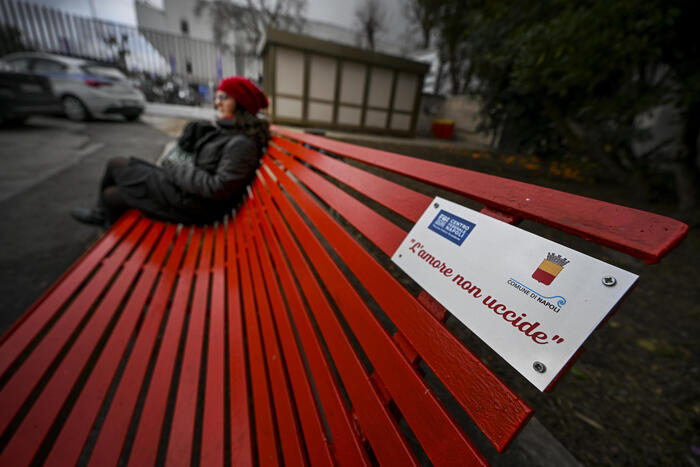On a motorway service area, a cinema or a restaurant, it is very easy to find women's toilets: these are the ones where a long queue condemns pressed bladders to wait while the traffic is "fluid" on the male side .
Anecdotal?
Nay.
This “particularity” is a sign of gender inequality in the very design of lavatories, which has been observed for decades.
However, nothing changes.
It is still just as laborious for women to reach this holy grail symbolized by the public toilet door.
What are the mysterious reasons that justify this state of affairs?
The women take the children with them
"I think the absolute nightmare is the toilets on motorway rest areas during a school holiday weekend," Laura analyzes.
From a very young age, she has been familiar with those of the A11 and the A87 which allow her to join her family in the Vendée from Paris.
“My father had time to relieve himself, have two coffees and smoke a cigarette when my mother, my sister and I had barely left the toilet.
Because, in addition to having to wait longer, women also most often accompany children, both girls and boys,” notes the student in Biological Engineering, dietetics option.
Read alsoBut why do our teenagers stay so long in the toilet?
Childcare for women increases the waiting time.
The fact that changing tables, when they are babies, are mostly present in their toilets, has something to do with this habit that is firmly rooted in people's minds.
But this unequal time to have access to amenities comes first of all from an equal distribution of spaces between women and men.
This is the paradox.
The toilets of some and the toilets of others often have the same surface area.
However, in the same space, you can stick more equipment to empty your bladder, on the male side, thanks to the urinal.
What I love is when I choose their empty toilets and some have the nerve to point out to me that "oh no, it's the men's toilet" when you have 20 girls in trouble next door .
I don't even understand how this remark is possible #privilègedupipi https://t.co/o5WtgJ2zCu
— Renée Greusard (@ReneeGr) April 25, 2022
“It is obvious that unzipping your fly takes less time than pulling down your pants, putting toilet paper on the toilet bowl when you sit down or adopting a balancing act to avoid touching it, changing protection if we have our period…”, enumerates Marianne.
Too bad for the disapproving looks and the comments “which come from elsewhere, especially women”, he happens to go to the men's where the closed toilets are often free.
“Let us have more toilets or mixed ones”, decides the one who has “apocalyptic memories” of crazy waiting before concerts.
Read alsoThe women victims of the syndrome of “the princess” who does not go to the toilet
Kurt Van Hautegem and Wouter Rogiest, two Belgian researchers from the University of Ghent have recently worked on the subject.
In their mathematical model, for two spaces of strictly equal areas, they were able to install 12 toilets for men (two closed cabinets and 10 urinals) against 10 toilets for women.
With this configuration, they calculated that women wait 6.19 minutes and men wait 11 seconds.
Mixed toilets would divide by 4 the wait for them
Already in 2009, the researcher in political science, Julien Damon, devoted a study * to the "right to relieve oneself" explaining that the subject remains "revealing of manifest inequalities and ground of possible innovations".
It is also based on a figure: women would spend 2.3 times more time in the toilet than men, physiological differences require.
And note that, sometimes, it pays off for them...
When the Belgian researchers put an end to the equal surface area of spaces dedicated to men and women, by installing 12 toilets for them and 10 for them (including 8 urinals), the waiting time for women fell dramatically: 2.18 minutes.
That of these gentlemen increases, him (a little), passing to 40 seconds.
But for the two researchers, as for Marianne, the best solution, that is to say the most egalitarian, consists in offering mixed toilets, made up of 14 cabinets and 8 urinals for everyone.
That is, 1.27 minutes of patience for women against 58 seconds for men.
The scientists add that this solution would also accommodate transsexual people.
yesterday pee break on the rest area and... Nothing changes: the women continue to queue in front of the women's toilets when the men's are free!
since I haven't stopped getting eng... on my bike lately, I haven't had the courage to go into battle!
#fatigue
— Sophie Bib 👠📚📸 #BCBG #BRI cyclette psecial unit (@bibalabib) November 2, 2022
"Women also spend more time in the toilets because they are cleaner, I see a lot of this among men who 'forget' washing their hands, for example," grimaces Imani.
The primary school teacher also votes for mixed toilets “but closed for everyone”.
“We have to stop believing that it doesn't bother young boys to go to the urinal.
And if ever one of them goes into a partitioned toilet, in the eyes of the others, it's necessarily because he's going to do the big errand there.
This can be the object of mockery since, it is well known, a man "pesses standing up", ironically the school teacher who takes the opportunity to vilify this gender stereotype.
The guys at the motorway service areas who say hello to their wives while having fun because there is a 10-minute queue for the women's toilets which leave them with the children while no queue at the men's toilets in which the kids can do pee, how smart is that?
🙄😡
— bouder's (@4bouders) December 26, 2021
If this separation, which dates from the 19th century, is not based on any logic, the solution of co-education is not unanimous among women, even less the urinal which has opened up to them.
Many of them fear possible aggression or lack of privacy, making them lean more towards positive discrimination, with additional toilets.
Nearly two centuries after the creation of pissotières (exclusively male), by the Comte de Rambuteau in Paris, it is clear that women should only pass through the public space... or hold back.
*“Public toilets: a right to better layout”, Droit social, n° 1, 2009, pp.
103-110.






/cloudfront-eu-central-1.images.arcpublishing.com/prisa/64JDMOK4HFKN7CYJUCYXZXUPCQ.jpg)


